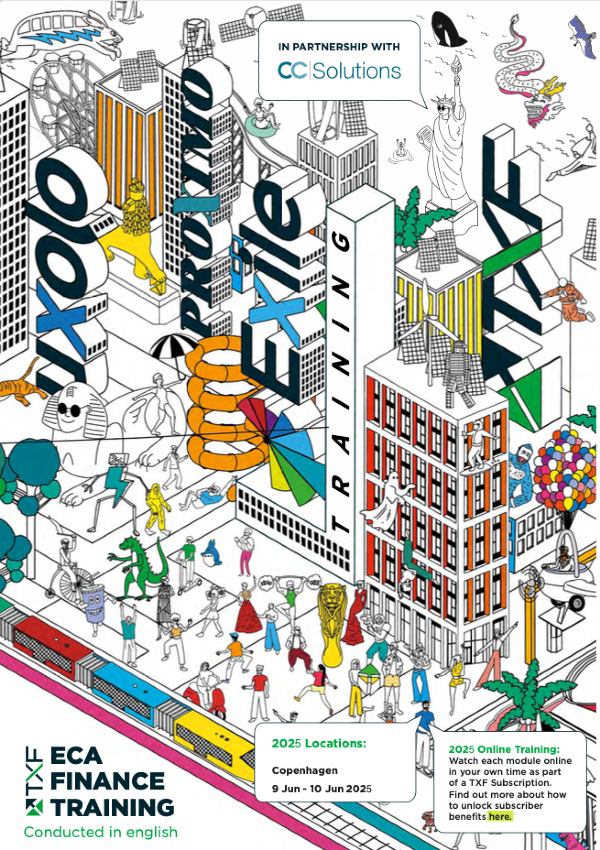TCFD in export finance: Does one size fit all?
Born out of the concern that financial institutions were not adequately accounting for their exposure to climate-related risks, TCFD has targeted industry-wide adoption, however many in the export finance sector remain ambivalent. So, where does TCFD stand, and what needs to be done to overcome industry inertia?

A recent report by the UN found that the world is on track to produce far more coal, oil and gas than is consistent with the output needed to limit global warming to two degrees, one of the core goals of the Paris Agreement. Unsurprisingly, media and consumer pressure is mounting on the export and project finance sector, which has become synonymous with carbon-intensive projects, to invest in more renewables and abandon hydrocarbon projects. Failure to adequately respond to this pressure can, and has, led to negative publicity, reactions from investors and the growing potential for reputational risk.
But it's not just the damage to the climate that has caused concern: the worse global warming becomes, the greater the risk that businesses themselves will suffer; seeing major disruptions to supply chains; damage to infrastructure and assets; not to mention potential regulation that governments might try to introduce as the climate crisis intensifies.
In view of this, the Financial stability board (FSB) set up the Task Force on Climate-Related Financial Disclosures (TCFDs) in order to aid business in the transition to a lower-carbon economy.
Finalised in 2017, TCFD’s goal is to gather voluntary and reliable climate-related financial information and to make said information freely available so that financial markets can price climate-related risks and opportunities correctly. It is hoped that this information will help to avoid sudden value shifts and destabilising costs as industries adapt to the new terrain. In essence, it's a tool to measure the impact of climate on business, not the impact of business on climate.
“TCFD seeks to ‘green the financial system’ and does so by posing a series of questions across four pillars, namely Governance, Strategy, Risk Management and Metrics & Targets.” said Mark Wakem, director of XB FinCo. “These are fundamentals of any well managed business and being invited to consider potential impacts of additional risks (ie climate change and adaptation) should be welcomed, not discouraged.”
“Be under no illusion, the transition to net zero will be disruptive. The sooner businesses of all sizes interact with the complexities of potential impacts & outcomes, the greater the chance they stand of still being in business in the decades to come. Think of TCFD as an added component to any Enterprise Risk Management system.”
TCFD in export finance
TCFD has gained notable prominence since it was established with 60% of the world’s 100 largest companies and 1,500 companies total now following TCFD reporting standards, according to the 2020 TCFD Status Report. However, industry enthusiasm has been tepid.
TXF’s Global Export Finance Industry Report 2021 reveals that more than a third of the banking respondents and nearly half of exporters and buyers have no intention to implement TCFD reporting standards at any point in the future.
Unfamiliarity with and a lack of understanding of TCFD, as TXF data shows, is commonplace, with approximately one-quarter of ECAs, one-third of banks and buyers, and more than half of exporters reporting having no knowledge of TCFD at all. Discounting those who are unaware of TCFD, qualitative data has identified a considerable reticence towards adoption of the framework industry-wide. A more detailed breakdown of TXF’s research on this topic can be found here.
Why is export finance dragging its feet on TCFD?
As referenced in the industry report, Covid-19 has had a big part to play, with considerable amounts of time and energy spent attempting to mitigate pandemic-induced damage, there simply isn't the bandwidth to properly grapple with TCFD for many organisations.
These are not the only obstacles. Wakem also points to the lack of in-depth understanding of the finer points of TCFD. “Currently, there is high level awareness of broad themes and the general direction of travel but woeful understanding of the detail,” says Wakem. “Partly that is due to the proliferation of well-intended, but often confusing, new benchmarks or reporting methodologies and partly due to both institutional and individual lethargy.”
While Wakem does not deny the complexities associated with TCFD implementation, he’s clear that this shouldn’t be used as an excuse. “TCFD has a range of online training resources and tools available and I’d encourage all export finance practitioners to make full use of them,” said Wakem.
“All the major banks active in export finance have dedicated teams of ESG & Sustainability professionals. Export financiers should engage with their colleagues and suggest seconding one or more into their own teams to achieve cross-pollination of knowledge. This also provides the banks with an excellent opportunity to actively support their clients by educating them and guiding them through materiality assessments, or engage in other climate disclosure-related knowledge sharing.”
A caveat to Wakem’s prognosis may be that while larger organisations with considerable resources at their disposal should be able to implement his suggestions without much exertion, it may prove taxing for smaller companies, many of which make up a considerable chunk of the export finance industry - from borrowers to exporters.
The one acronym to rule them all
Another potentially confusing aspect to this subject is the existence of multiple other frameworks and branching pathways that have considerable overlap with TCFD. For instance, the UN Sustainable Development Goals (SDG), and the EU taxonomy for sustainable activities, are similarly focused on encouraging sustainable projects and activities. To top this off, just last week Mark Carney and several other luminaries launched GFANZ (The Glasgow Financial Alliance for Net Zero). While all of these frameworks and guidelines orbit the same goal, transitioning to net zero emissions by 2050, they are not interchangeable, as Wakem explains.
“SDGs are a set of targets (or Goals) to be aimed for. TCFD can provide a framework to help assess activity as being either positive or negative in respect of achieving them and EU Taxonomy helps to define positive or sustainable activity.”
With this blend of concerns and complications involved in the roll out of TCFD it is perhaps not surprising that the TCFD 2020 status report itself admits that “...companies’ disclosure of the potential financial impact of climate change on their businesses and strategies remains low.”
Increasing TCFD adherence across export finance
In light of TCFD’s current standing within export finance, Wakem underlines two key factors that will hasten TCFDs adoption across the industry, Education and Motivation.
“Education is critical and it may need to be compulsory,” says Wakem. “I would expect major banks to include a TCFD and broader climate risk & adaptation training module within their internal good governance & compliance training regimes. The FCA and other regulatory bodies may need to get prescriptive, but their current thinking seems to be focussed on ‘green products’ / sustainable investments.”
Education alone won't be enough to build uniformity across the industry, as Wakem points out. “Motivational factors are also key, looking at both financial incentives for banks and bankers, but also regulatory drivers.”
Wakem continues: “Historically, TCFD reporting has been voluntary, although the UK Government has now made TCFD aligned disclosures mandatory for UK financial institutions and has articulated a roadmap for increasing the scope of entities obliged to report.”
TCFD going forward: the end of voluntary reporting?
As mentioned by Wakem, last November the UK government announced measures in line with TCFD, expecting that by 2022 all companies listed on the LSE, as well as nearly all of banks, insurers and pension funds will comply with the new reporting standards. As host to the world's third largest stock exchange the UK's announcement was an important boost to TCFD’s mission.
During the same period the European Central Bank also published its Guidance on Climate related and Environmental Risk for Banks, a set of guidelines that integrate the recommendations of TCFD. The binding ECB guidelines mean that Euro-zone banks complying with ECB Guidance makes them instantly compliant with TFCD.
With increasing interest from governments to introduce mandatory reporting laws, export finance players in jurisdictions not bound by such laws, and who choose not to integrate TCFDs, may find themselves at greater exposure to climate induced risk than their European counterparts.





